
IGCSE Biology Comprehensive and Free Notes 2022
IGCSE Biology Comprehensive and Free Notes 2022
What are the IGCSE Biology Comprehensive and Free Notes 2022?
Cracking the IGCSE Biology 2022 Examination might seem tedious at times.
Often students are unable to score their desired grade despite being thorough with their theory.
This could be due to minor mistakes and negligence.
In a nutshell, this article by Tutopiya on IGCSE Biology Comprehensive and Free Notes 2022
provides all-inclusive guidance to students.
Moreover, it is a combination of an analysis of previous candidate’s mistakes and other helpful tips
on how to ace their IGCSE Biology exam with this IGCSE Biology Comprehensive and Free Notes 2022

IGCSE Biology Comprehensive and Free Notes 2022 Comprises of:
- General tips and guidance on how to manage answering the IGCSE Biology 2022 Papers
- Some tips on how to read questions and understand question words
- Importance of calculations, referential questions, graphs, table and diagrams
- Answering IGCSE Biology MCQ’s
- Answering Essay and Theoretical questions
- Importance of Key terms and their usage

Overview of the Assessment Objectives for IGCSE Biology 2022
Understanding the learning objectives of the IGCSE Biology 2022 Examinations will make achieving the desired grade easier
How?
Figuring out what the assessment objectives require in the IGCSE Biology examinations will help
students answer the exams better resulting in the receiving the highest grade.
Basically, assessment objectives show students what is required of them in the examinations.
Once students master that, examiners will know that students have learnt what they were supposed to.
Students also need to know how many papers they must answer in the examination and the nature of these papers.
Number and Nature: Core and Extended
All candidates take THREE papers as mentioned in the Cambridge Examinations Website
Candidates who have studied the Core syllabus, or are expected to achieve grade D will sit for the following papers
Paper 1, Paper 3 and EITHER Paper 5 or Paper 6
These candidates will be eligible for grades C to G
Students who have studied the Extended syllabus (Core and Supplement), and who are
expected to achieve a grade C or above will sit for the following papers
Paper 2, Paper 4 and EITHER Paper 5 or Paper 6
They will be eligible for grades A* to G.
Assessment Objectives for IGCSE Biology 2022
-
Knowledge and Understanding 50%
Candidates are required to demonstrate a sound knowledge and understanding of the following aspects:
- Scientific phenomena, facts, laws, definitions, concepts and theories
- Biological and scientific vocabulary, terminology and conventions
- Instruments and apparatus, including techniques of operation and aspects of safety
- Technological and Scientific applications with their social, economic and environmental implications.
Students are asked to recall and explain these important aspects throughout their assessments.
Moreover, they will also be asked questions that require them to apply this material to unfamiliar contexts and to apply knowledge from one area of the syllabus to another.
2. Handling information with Problem Solving 30%
This objective deals with analysis and manipulation of scientific data.
Students are required to read, organize, calculate, report, present, analyze and relate scientific data.
They may do this in words or in the formal of graphical interpretations, tables, calculations, patterns, and other relationships.
Predicting hypotheses and solving problems including scientific relationships is also a vital factor.
Questions based on this objective may be from subject content familiar or unfamiliar to the student.
3. Experimental Skills and Investigations 20%
Experimental and Investigative skills are given importance in this objective.
In addition, Examiners look for the skills listed below to reward points.
- Dealing safely with scientific instruments and apparatuses of measurement or experimentation.
- Planning scientific experiments
- Understanding the wisdom behind the scientific method
- Reporting and presenting data or results collected from the procedure.
- Interpreting and evaluating the results
Analysis and suggestions based on the results and the procedure

General Tips For Students for IGCSE Biology 2022
-
Time Management
Time Management is a key factor in all IGCSE Biology papers.
More importantly, for Paper 1 and 2, which are multiple-choice questions.
Furthermore, multiple-choice questions require students to be quick and steady.
Students must make sure they manage time well and allocate time to answer easy and difficult questions together.
If for example, the difficult questions require more time, then candidates must focus on the easy
ones first and after that, go back to the tough ones.
Paper 3 and 4 require students to answer short questions that need short answers, calculations or diagrams.
It’s important to note the number of marks allocated for each question.
Usually, 1 or 2 mark questions are quick and easy.
2 or more mark questions require more timing and description.
Paper 5 and 6 are practical papers that consist of a variety of questions with a varied number of marks.
Students must be prepared for different questions and most importantly, manage time efficiently.
Try Tutopiya’s printable study and revision planners to help you plan your revision schedules.

-
Keywords and Key terms in Answers
IGCSE Biology is an examination that wants students to use the correct keywords, concepts and terms.
Students will score the marks they need when they use the main keywords and terms that have marks allocated to them.
It’s important to memorize and understand the key terms and definitions for each chapter of theory.
Above all, theoretical concepts and terms must be used when answering questions.
Students must use a variety of tools like highlighting and underlining that can help them memorize such keywords.
In addition to that making, short notes will help store all the keywords in the long term memory.
Finding the right textbooks that can help you study can be tricky, use this guide to find out what textbooks you need for IGCSE Biology:
CLICK ON THE LINK BELOW!
https://www.tutopiya.com/blog/best-cambridge-igcse-and-edexcel-igcse-prep-books/
-
Using Tools to Understand Question Words
Understanding question words is a critical part of answering exam questions and scoring good grades.
Questions testing objectives of understanding and knowledge will have question words like; define the state, describe and explain.
Other questions testing for evaluation and problem solving or experiments will have question words suggest, predict, calculate or determine.
Long essay questions on comparison and analysis questions will begin with; analyze, evaluate and assess.
Each word has a purpose, answering questions based on what the question word is asking is key to scoring better.
-
Importance of Diagrams, Equations, Calculations and Charts Essay Questions
According to the requirement of the question, providing the right example is important.
Examples, calculations, diagrams and equations are all part of the understanding and knowledge objective.
These tiny details will only propel the student forward.
The examiner should be able to see that the student is confident in applying the knowledge learnt to different concepts.
-
Why Practice is Important
Ever heard of the phrase practice makes perfect?
Practice helps students to face the papers in the examination confidently.
Every student is different and approaches the papers in different ways.
Above all, this process helps students familiarize themselves with the answering process.
In other words, practising past papers is a vital part if revision.
Students can benefit in several ways from practising past papers as follows:
- Learning to manage time
- Noticing a pattern in the questions
- Mark allocation
- How to approach questions
Allocating time for past paper practice in your study plan and schedule is a very vital step.
No revision session is complete without a past paper practice session.
For more tips on how to prepare for the IGCSE Biology Examination CLICK HERE
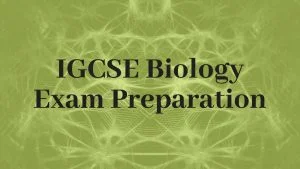
Past Paper Sample Questions with Mark Scheme Answers
Multiple Choice Question –Paper 1 and 2
Sample Question
PAPER 1
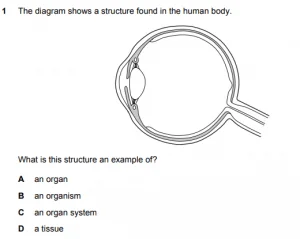
2.
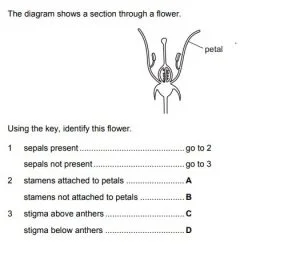
PAPER 2
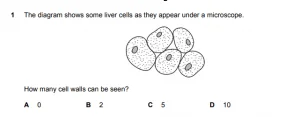
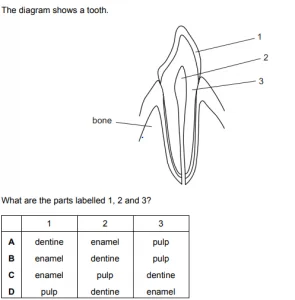
PAPER 3
3. Fig. 3.1 shows a fetus developing inside the uterus.
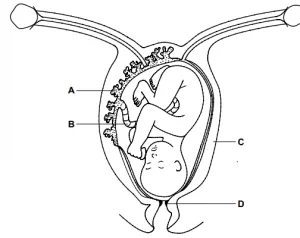
Fig. 3.1
(a) The fetus developed from a fertilised egg cell.
Put an X on Fig. 3.1 to show where an egg cell is normally fertilised. [1]
(b) State the functions of the structures labelled A and B. A … B … [2] (c) Describe the roles of the structures labelled C and D during labour and birth. C … … D … … [2] [Total: 5]
PAPER 4
- The dominant grass species in an African grassland ecosystem are star grass and red oat grass. • Star grass is eaten by antelope species, such as topi and Thomson’s gazelle. • Smaller animals such as mice and grasshoppers feed on red oat grass. • Topi and Thomson’s gazelle are eaten by predators such as cheetahs, lions and serval cats. • Grasshoppers and mice are eaten by serval cats and tawny eagles. • Vultures feed on dead mammals. Fig. 1.1 shows part of the food web for this ecosystem
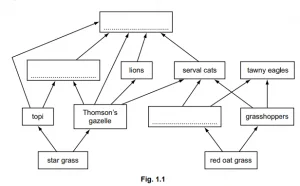
(a) Complete the food web by writing the names of the correct organisms in the boxes in Fig. 1.1. [3] (b) Name the trophic level of the following species. star grass … topi … [2]
(c) (i) State the principal source of energy for the food web shown in Fig. 1.1. … [1] (ii) State what happens to energy when it leaves a food web. … [1]
(d) Explain why there are no more than four trophic levels in the food web shown in Fig. 1.1. … … … … … … [3]
(e) Fish such as salmon can be reared intensively in fish farms. They are fed on high protein food made from animals. When eating this food, the fish are feeding as secondary consumers. Describe the disadvantages of intensive farming, such as salmon farming, for producing human food. … … … … … … [3] [Total: 13]
IGCSE BIOLOGY 2020 MARKS SCHEME ANSWERS
PAPER 1
Question 1 Answer = A
Question 2 Answer = A
PAPER 2
Question 1 Answer = A
Question 2 Answer = C
PAPER 3
ANSWER FOR QUESTION GIVEN
3 (a) X – placed clearly on oviduct; allow: X with label line clearly indicating oviduct [1] (b) A – transfer of nutrients from mother to fetus/transfer of oxygen from mother to fetus / removal of CO2 from fetus to mother/removal of waste from fetus to mother; note: direction of transport must be clear B – carries fetal blood to and from the placenta; [2] (c) C – contracts to push a baby (out); D – dilates to allow exit of baby/owtte; [2]
PAPER 4
ANSWER FOR QUESTION GIVEN
(a) animals written in the correct boxes in the food web vultures; cheetahs; mice/mouse;
(b) (primary) producer; primary consumer;
(c) (i) Sun; [1] (ii) (lost) to the atmosphere / (lost as) infra-red (radiation) / heat / owtte; [1]
(d) Any three from: the idea that a small percentage of energy from the Sun is ‘fixed’ by photosynthesis / most energy from Sun not available / reference to the wrong wavelength; energy is lost between and within trophic levels; ref. to 10% energy transfer / ora (per trophic level); note: if the magnitude is given, e.g. ‘90% lost between trophic levels’, award 2 marks ref. to material that is inedible or indigestible; ref. to (small) total percentage reaching the fourth trophic level (cumulative idea); not enough energy in the fourth trophic level to support another level; AVP; [max 3]
(e) Any three from: the feed is expensive; more energy-efficient to feed humans on crops or producers or animals that are used to make the (fish) food; waste feed causes eutrophication of water supplies; diseases or parasites spread easily (in captivity); diseases spread to other organisms in the wild; chemicals used to control the disease are also pollutants (e.g. antibiotics); AVP; e.g. animal welfare concerns [max 3]
SIGN UP BELOW FOR AN INSTANT FREE 60 MIN TRIAL FOR ANY TOPIC IN IGCSE BIOLOGY
Written by
Tutopiya Team
Educational Expert
Related Articles

IGCSE Math Study Tips - Science-based Study Tools To Ace Your Exams
The IGCSE Math syllabus builds students' foundation for mathematical concepts. This prepares students for tertiary mathematics

Expert IGCSE Maths Tutor in Hong Kong | Personalized Lessons
Expert IGCSE Maths tutors in Hong Kong offer personalized lessons for top grades. Unlock your potential with tailored tuition for IGCSE, IB, & A-levels.

Tutopiya: Revolutionizing IGCSE Tutoring for Academic Success
What Makes Tutopiya the Best Choice for IGCSE Tutoring. The _IGCSE exams_ are a significant milestone in a student's academic journey



